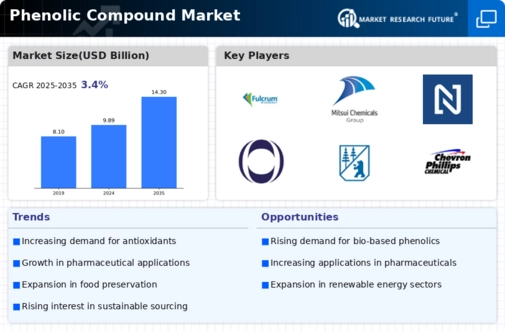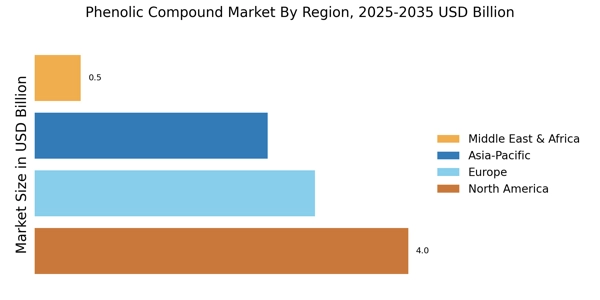Growing Awareness of Health Benefits
The Phenolic Compound Market is experiencing growth due to the increasing awareness of the health benefits associated with phenolic compounds. These compounds are recognized for their antioxidant properties and potential health benefits, which are driving their incorporation into dietary supplements and functional foods. The global market for functional foods is projected to grow significantly, with phenolic compounds playing a crucial role in this expansion. As consumers become more health-conscious, the demand for products containing phenolic compounds is likely to rise, potentially leading to a market growth rate of around 5% annually. This trend not only highlights the versatility of phenolic compounds but also underscores their importance in promoting health and wellness, thereby enhancing their market appeal.
Rising Demand in the Automotive Sector
The Phenolic Compound Market is witnessing a surge in demand from the automotive sector, driven by the need for lightweight and high-performance materials. As automotive manufacturers strive to improve fuel efficiency and reduce emissions, phenolic compounds are increasingly being utilized in the production of components such as brake pads, insulation materials, and structural parts. The automotive industry is projected to grow at a rate of approximately 4% annually, which could significantly impact the phenolic compound market. Additionally, the shift towards electric vehicles is likely to further enhance the demand for advanced materials, including phenolic compounds, as they offer superior thermal stability and mechanical properties. This trend indicates a promising future for the phenolic compound market, particularly in the context of evolving automotive technologies.
Regulatory Support for Sustainable Practices
The Phenolic Compound Market is likely to benefit from increasing regulatory support aimed at promoting sustainable practices. Governments and regulatory bodies are implementing stringent environmental regulations that encourage the use of eco-friendly materials. This trend is particularly relevant for phenolic compounds, which can be derived from renewable resources. The push for sustainability is prompting manufacturers to explore bio-based phenolic compounds, which may reduce reliance on fossil fuels. As a result, the market for phenolic compounds derived from sustainable sources is expected to grow, potentially reaching a valuation of several billion dollars in the coming years. This regulatory environment not only fosters innovation but also aligns with consumer preferences for environmentally responsible products, thereby enhancing the overall market landscape.
Increasing Applications in Various Industries
The Phenolic Compound Market is experiencing a notable expansion due to the increasing applications of phenolic compounds across diverse sectors. These compounds are utilized in the production of resins, adhesives, and coatings, which are essential in construction, automotive, and electronics. The demand for high-performance materials in these industries is driving the growth of the phenolic compound market. For instance, the construction sector is projected to witness a compound annual growth rate of approximately 5% over the next few years, thereby enhancing the demand for phenolic-based products. Furthermore, the automotive industry is increasingly adopting phenolic compounds for lightweight and durable components, which could further bolster market growth. As industries continue to innovate, the versatility of phenolic compounds positions them as a critical component in various applications.
Technological Innovations in Production Processes
The Phenolic Compound Market is being propelled by technological innovations that enhance production processes. Advances in manufacturing techniques, such as the development of more efficient catalytic processes and the use of alternative feedstocks, are likely to improve the yield and quality of phenolic compounds. These innovations not only reduce production costs but also minimize environmental impact, aligning with the growing emphasis on sustainability. For instance, the introduction of continuous production methods could streamline operations and increase output, potentially leading to a market growth rate of around 6% in the next few years. As manufacturers adopt these cutting-edge technologies, the phenolic compound market is expected to evolve, offering new opportunities for growth and development.


















Leave a Comment